Figures & data
Figure 1 Effect of different doses (g/kg) of the aqueous extract of T. indica. pulp (AeTp) by oral route on the rectal temperature in febrile Wistar rats with respect to the time course. Each value represents the mean (n = 6) of the changes in febrile temperature (Δ°C)±SD for each time. Experimental groups were compared with the control group. *p < 0.05, **p < 0.001.
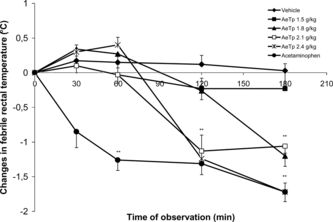
Figure 2 Effect of TpPs on the colonic temperature with respect to the time course in febrile BALB/c mice. Each value represents the mean (n = 5) of the changes in febrile temperature (Δ°C)±SD for each time, with respect to time 0, when treatments were orally administered. *p < 0.05, **p < 0.001.
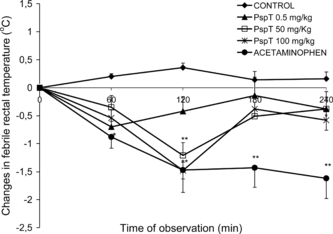
Figure 3 TpPs was added in doses of 0.005, 0.05, 0.5, 5, 50, and 100 µg/mL, compared with cytokine secreted in LPS-stimulated cells (10 µg/mL), to which TpPs was added afterwards. The open bar corresponds with cells in medium alone, and the solid bar with cells stimulated only with LPS. Values represent the mean and SD of three experiments. *p < 0.01, **p < 0.005 compared with the concentration of cells stimulated only with LPS. Student's t.-test.
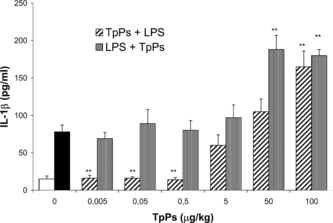
Figure 4 IL-1β concentration in the supernatant of PECs in culture. Cells were stimulated with LPS (10 µg/mL) to which TpPs was added afterwards at 0.005, 0.05, 0.5, 5, 50, and 100 µg/mL doses; the IL-6 secreted was compared with those to which TpPs had been added previously. The open bar corresponds with IL-1β in medium alone, and the solid bar corresponds with cytokine secreted only with LPS. Values represent the mean and SD of three experiments. **p < 0.005 compared with LPS. Student's t.-test.
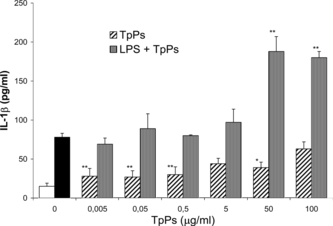
Figure 5 Concentration of IL-6 in supernatants of PEC culture. Cells were stimulated with LPS (10 µg/mL) to which TpPs was added at 0.005, 0.05, 0.5, 5.0, 50.0, and 100.0 µg/mL, and IL-6 levels were compared with those that received only TpPs. The open bar corresponds with cells cultured in medium alone, and the solid bar corresponds with cells stimulated only with LPS. Values represent the mean and SD of three experiments. **p < 0.005 compared with LPS. Student's t.-test.
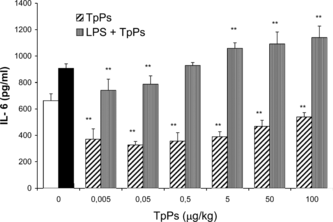
Figure 6 Effect of TpPs on IL-6 concentration. Peritoneal cells in culture were stimulated with LPS (10 µg/mL) to which TpPs was then added at 0.005, 0.05, 0.5, 5.0, 50.0, and 100.0 µg/mL, compared with those that received first TpPs and then were stimulated with LPS. The open bar corresponds with IL-6 in medium alone, and the solid bar with cytokine secreted by cells stimulated only with LPS. Values represent the mean and SD of three experiments. *p < 0.01, **p < 0.005 compared with LPS. Student's t.-test.

Table 1.. Effect of different doses of T. indica. pulp polysaccharide (TpPs) on stimulation cellular response (%) for IL-1 and IL-6 cells release in the different stimulation protocols.
